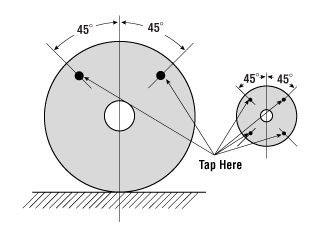Handling and Storing of Bonded Abrasive Wheels – Fact Sheets
WHAT SAFETY PRECAUTIONS SHOULD YOU FOLLOW WHEN USING ABRASIVE WHEELS?
- Select the right wheel for the job. It is important for safety. A wheel is dangerous when used for work for which it was not designed. Booklets from wheel and machine manufacturers provide technical information on wheel selection and proper use.
- Use only wheels marked with the type of wheel and maximum speed in revolutions per minute (rpm).
- Inspect the wheel upon receipt.
- Visually examine the wheel for any signs of damage such as chips and gouges.
- Use “ring test” to check if the wheel is damaged. Ring tests do not apply to small wheels 10 cm (4 in.) diameter and smaller.
- Use abrasive wheels only on machines with safety guards. Exceptions may apply to some classes of wheels. Always check with the manufacturer’s instructions.
What is the “ring test?”
- The ring test is one way to check whether the wheel is cracked or damaged. Ensure the wheel is clean and dry. Tap wheels gently with a nonmetallic tool such as a plastic screwdriver handle for light wheels and a wooden mallet for heavy wheels.
- Tap wheels about 45 degrees each side of the vertical center line and about 3 to 5 cm (1 or 2 in) from the periphery. Repeat the test by rotating the wheel 45 degrees.

An undamaged wheel will emit a metallic ring. Reject any wheel that sounds dead or cracked and does not have a clear ring.
How should you handle and store the abrasive wheels?
All abrasive wheels are fragile.
- Handle wheels carefully. Avoid dropping or bumping.
- Do not roll a wheel on its edge.
- Transport wheels in containers designed to provide support for the wheels if they are too heavy to carry by hand.
- Do not pile other items such as tools on top of wheels.
- Store wheels in racks or bins with dividers for different types of wheels and ensure easy access and less handling.
- Place straight or tapered wheels on end in a cradle or chocked position to prevent rolling.
- Never store wheels near excessive heat or cold, in contact with water, oil or moisture, nor in drawers with loose tools.
- Store wheels in a dry area. When selecting the racks, bins, boxes or drawers for storage consider the size and type of wheels to be stored: for example, lay flat thin bonded wheels, and support larger wheels in racks. Always follow the manufacturer’s instructions.
- Sort and store wheels in such away that older wheels can be selected first.
- Follow the manufacturer’s instructions for length of time a wheel should be stored.
Source: © Copyright 1997-2021 CCOHS